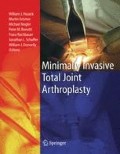Abstract
The recent surge in interest in minimally invasive approaches for total hip arthroplasty has captured the attention of both surgeon and patient and resulted in a proliferation of new surgical techniques. Simultaneously we are experiencing the introduction of computerized navigation systems for total hip arthroplasty that enables the surgeon to more accurately and reproducibly perform bone preparation and component insertion. Both of these new technologies are still in their infancy and will continue to evolve markedly over forthcoming years, with surgeon experience and most importantly the results of appropriately constructed and performed clinical trials directing their path. The use of computerized navigation in total hip replacement allows the advantages of minimally invasive surgery to be combined with the safety of anatomical and other information available to the surgeon previously only afforded by more invasive exposures.
Access this chapter
Tax calculation will be finalised at checkout
Purchases are for personal use only
Preview
Unable to display preview. Download preview PDF.
References
Murray, D.W., AJ. Carr, C.J. Bulstrode. Which primary total hip replacement? J Bone Joint Surg Br 1995. 77 (4): 520–527
Ali Khan, M.A., P.H. Brakenbury, I.S. Reynolds. Dislocation following total hip replacement. J Bone Joint Surg Br, 1981.63-B(2): 214–218
Demos, H.A., et al. Instability in primary total hip arthroplasty with the direct lateral approach.Clin Orthop 2001. (393): 168–180
Dorr, L.D., Z. Wan. Causes of and treatment protocol for instability of total hip replacement. Clin Orthop 1998. (355): 144–151
Grossmann, P., M. Braun, W. Becker. Dislocation following total hip endoprosthesis. Association with surgical approach and other factors. Z Orthop Ihre Grenzgeb 1994. 132 (6): 521–526
Hirakawa, K. et al. Effect of acetabular cup position and orientation in cemented total hip arthroplasty. Clin Orthop 2001.(388): 135–142
Kennedy, J.G. et al. Effect of acetabular component orientation on recurrent dislocation, pelvic osteolysis, polyethylene wear, and component migration. J Arthroplasty, 1998. 13 (5): 530–534
McCollum, D.E., WJ. Gray. Dislocation after total hip arthroplasty. Causes and prevention. Clin Orthop 1990. (261): 159–170
DiGioia, A.M. et al.The Otto Aufranc Award. Image guided navigation system to measure intraoperatively acetabular implant alignment. Clin Orthop 1998. (355): 8–22
Lewinnek, G.E. et al. Dislocations after total hip-replacement arthroplasties. J Bone Joint Surg Am 1978. 60 (2): 217–220
Paterno, S.A., P.F. Lachiewicz, S.S. Kelley. The influence of patient- related factors and the position of the acetabular component on the rate of dislocation after total hip replacement. J Bone Joint Surg Am 1997. 79 (8): 1202–1210
Berger, R.A. Total hip arthroplasty using the minimally invasive two-incision approach. Clin Orthop 2003 (417): 232–241
Higuchi, F. et al. Minimally invasive uncemented total hip arthroplasty through an anterolateral approach with a shorter skin incision. J Orthop Sci 2003. 8 (6): 812–817
Rodrigo, J.J.,Juan J. Rodrigo. MD on minimally invasive hip surgery. Orthopedics, 2002. 25 (10): 1016–1028
Sherry, E. et al. Minimal invasive surgery for hip replacement: a new technique using the NILNAV hip system. ANZ J Surg, 2003. 73 (3): 157–161
Waldman, B.J. Advancements in minimally invasive total hip arthroplasty. Orthopedics, 2003. 26 [8 Suppl]: S833–836
Wenz, J.F., I. Gurkan, S.R. Jibodh. Mini-incision total hip arthroplasty: a comparative assessment of perioperative outcomes. Orthopedics 2002. 25 (10): 1031–1043
Digioia, A.M., 3rd et al. Mini-incision technique for total hip arthroplasty with navigation. J Arthroplasty, 2003. 18 (2): 123–128
Leenders.T. et al. Reduction in variability of acetabular cup abduction using computer assisted surgery: a prospective and randomized study. Comput Aided Surg, 2002. 7 (2): 99–106
Mielke, R.K. et al. Navigation in knee endoprosthesis implantation-preliminary experiences and prospective comparative study with conventional implantation technique. Z Orthop Ihre Gren-zgeb 2001. 139 (2): 109–116
Sparmann M. et al. Knieendoprothesennavigation mit dem Stryk- er-System. In: Konermann H.R. (ed) Navigation und Robotic in der Gelenk- und Wirbelsaulenchirurgie. Springer, Berlin Heidelberg New York Tokio. 2003. pp 250–255
Jenny J.Y. et al. Navigated implantation of total knee endoprostheses - a comparative study with conventional instrumentation. Z Orthop Ihre Grenzgeb, 2001. 139: 117–119
Digioia, A.M. III et al. Comparison of a mechanical acetabular alignment guide with computer placement of the socket. J Arthroplasty, 2002. 17 (3): 359–364
Schep, N.W. et al. Validation offluoroscopy-based navigation in the hip region: what you see is what you get? Comput Aided Surg 2002. 7 (5): 279–283
Zheng, G. et al. A hybrid CT-free navigation system for total hip arthroplasty. Comput Aided Surg, 2002. 7 (3): 129–145
Editor information
Editors and Affiliations
Rights and permissions
Copyright information
© 2004 Springer Medizin Verlag Heidelberg
About this chapter
Cite this chapter
Donnelly, B. (2004). Double-Incision and Mini-Posterior Total Hip Arthroplasty Using Imageless Navigation. In: Hozack, W.J., et al. Minimally Invasive Total Joint Arthroplasty. Springer, Berlin, Heidelberg. https://doi.org/10.1007/978-3-642-59298-0_32
Download citation
DOI: https://doi.org/10.1007/978-3-642-59298-0_32
Publisher Name: Springer, Berlin, Heidelberg
Print ISBN: 978-3-642-63926-5
Online ISBN: 978-3-642-59298-0
eBook Packages: Springer Book Archive

